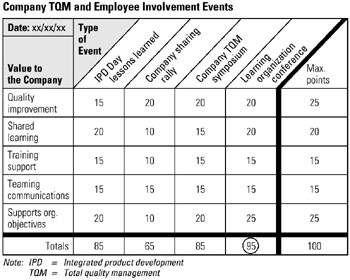Tool 135: Point-Scoring Evaluation
| AKA | Criteria Rating Form |
| Classification | Decision Making (DM) |
Tool description
A point-scoring evaluation rates the importance, value, or preference of listed solutions, factors, or issues by the assignment of points to every alternative, not to exceed a team-set maximum of 100 or 1000 points of all listed alternatives. This rating system effectively supports a team's consensus decision-making effort.
Typical application
-
To review and rate all listed alternatives.
-
To select, by numerical rating, a team's preferred solution, factor, or issue.
-
To team-rate the importance, value, or best option of a matrix of factors.
Problem-solving phase
| Select and define problem or opportunity | |
| → | Identify and analyze causes or potential change |
| → | Develop and plan possible solutions or change |
| Implement and evaluate solution or change | |
| → | Measure and report solution or change results |
| Recognize and reward team efforts |
Typically used by
| 1 | Research/statistics |
| Creativity/innovation | |
| 2 | Engineering |
| Project management | |
| Manufacturing | |
| 3 | Marketing/sales |
| Administration/documentation | |
| Servicing/support | |
| 4 | Customer/quality metrics |
| Change management |
before
-
Selection Matrix
-
Rating Matrix
-
Ranking Matrix
-
Weighted Voting
-
Solution Matrix
after
-
Problems Selection Matrix
-
Project Prioritization Matrix
-
Starbursting
-
Run-It-By
-
Different Point of View
Notes and key points
-
When point-scoring, use a total of 100 or 1000 points for the distribution across problems, elements, conditions, factors, issues, or ideas.
Step-by-step procedure
-
STEP 1 The team facilitator reviews the process of point-scoring with the team.
-
STEP 2 A point-scoring matrix is drawn on a flip chart or whiteboard. All factors are discussed and recorded in teh matrix. See example Company TQM and Employee Involvement Events.
-
STEP 3 Next, the team decides on the maximum number of points to be distributed: 100 or 1000 points. In this example 100 points were distributed.
-
STEP 4 The facilitator now guides the participants through the evaluation of each listed alternative and arrives at a team rating of points to be assigned to reach the preferred alternative.
-
STEP 5 The point-scoring matrix is filled and all columns are added to show the highest total. This is the preferred alternative. In this example, 95 points reflect the team's choice.
-
STEP 6 The matrix is checked for accuracy and dated.
Example of tool application

EAN: 2147483647
Pages: 326